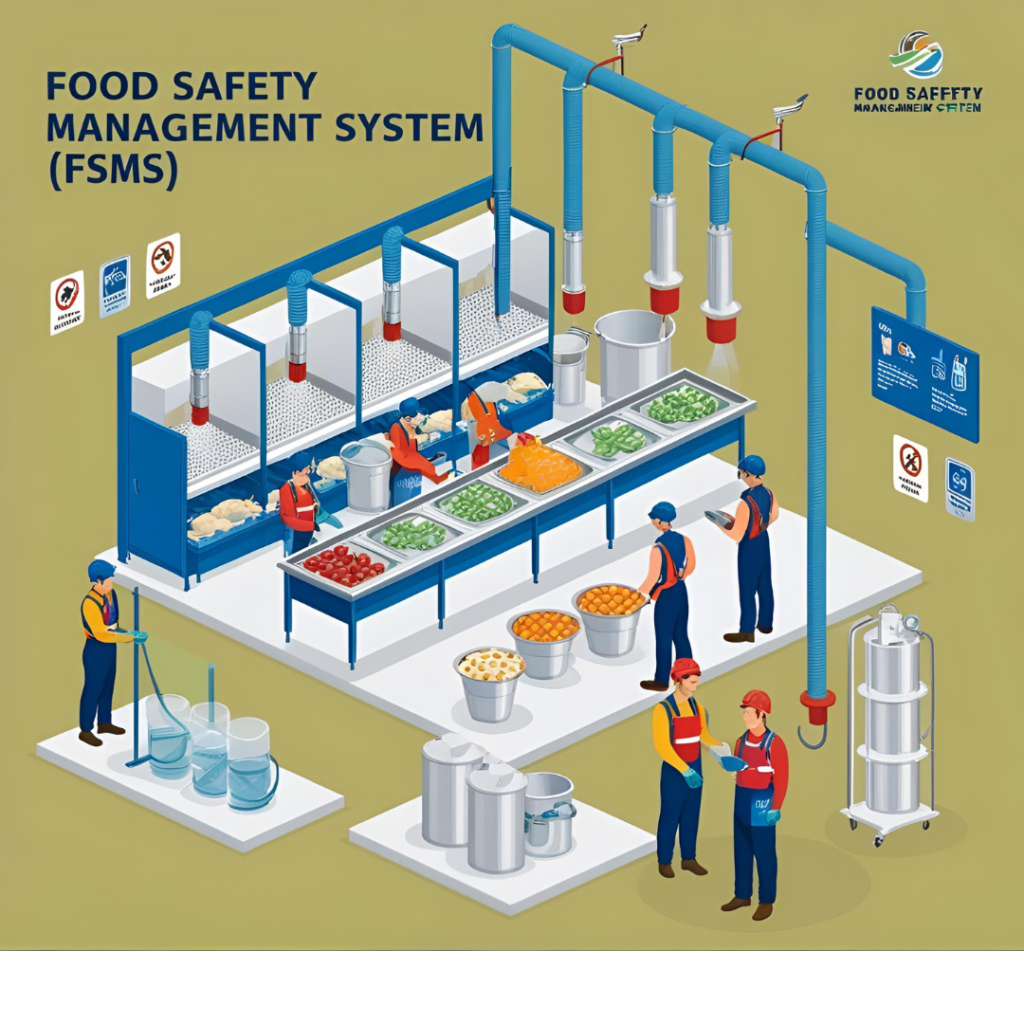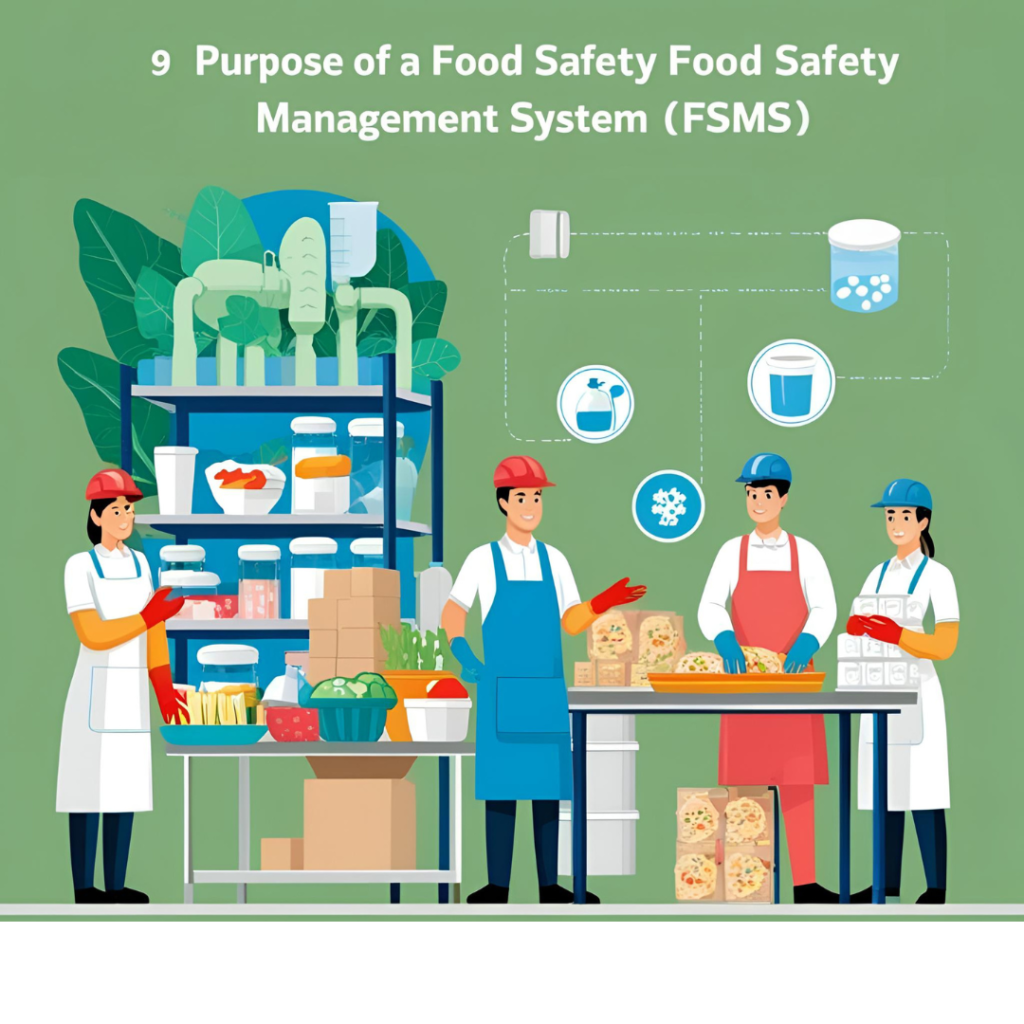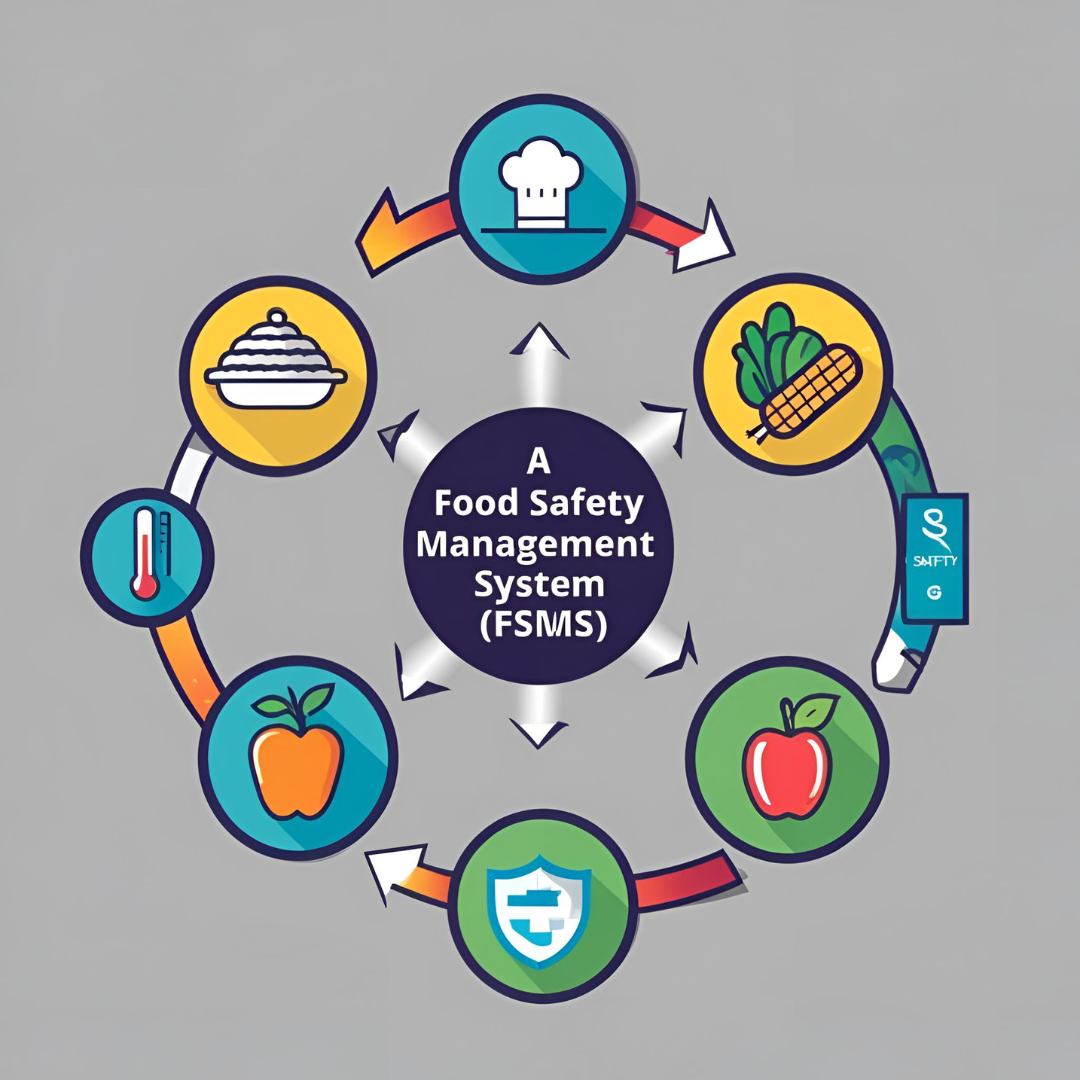Introduction
Food Safety Management System
Food safety is a serious problem that affects us all. When food becomes contaminated, it can cause major health problems, financial losses and even harm the company’s reputation. The World Health Organization (WHO) reports that more than 600 million people are ill every year due to food diseases, resulting in approximately 420,000 deaths worldwide. Food companies need to adopt the Food Safety Management System (FSM) to solve these problems. This is a systematic way to identify, control and prevent food safety hazards at all sections of the supply chain. In this article, we will go into everything you need to know about the FSMS, including its goal, the benefits of how it works, the essential documents, the certification process and the answers to the usual questions.
What is a Food Safety Management System (FSMS)?

A food safety management system (FSMS)is actually a structured approach that food businesses and manufacturing entities use to identify, assess, manage, and monitor food safety risks, ensuring that what we eat is safe. It combines policies, procedures, and best practices to meet regulatory standards, while also ensuring that food products are of the highest quality.
At its core, FSMS is based on the principles of Hazard Analysis and Critical Control Points (HACCP) and includes a variety of food safety standards, such as:
- ISO 22000:2018 – global standard for food safety management that takes a risk-based approach.
- HACCP (Hazard Analysis and Critical Control Points) – A proactive system designed to manage potential hazards in food safety.
- GFSI (Global Food Safety Initiative) Standards – This encompasses certifications like BRCGS, SQF, and FSSC 22000.
- FSSAI (Food Safety and Standards Authority of India) – It is a regulatory framework in India that ensures food safety compliance.
Purpose of a Food Safety Management System (FSMS)

1. Preventing Foodborne Illnesses & Contamination
Food Safety Management Systems (FSMS) are very important to prevent foodborne illnesses. Many of the diseases can be caused by the following food hazards:
✅ Biological hazards – bacteria, viruses, fungi and parasites such as Salmonella, E. coli, Listeria.
✅ Chemical hazards – chemicals such as pesticides, heavy metals, food additives and allergens.
✅ Physical hazards – foreign objects such as glass, plastic, small pieces of metal or stone.
If hazards are identified at the beginning and managed properly, FSMS can significantly reduce the risk of contamination and make your food safe at every stage. 🚀
2. Ensuring Compliance with Food Safety Regulations
Food businesses have to follow national and international food safety laws to avoid penalties, recalls and even shutdowns.
✅A Food Safety Management System (FSMS) is a must which helps organizations meet these requirements:
🔹 ISO 22000 & HACCP Certification
🔹 Food Safety Modernization Act (FSMA, USA)
🔹 EU Food Safety Regulations
🔹 FSSAI Licensing & Standards (India)
🔹 Codex Alimentarius Guidelines (International Food Standards)
If this compliance is followed correctly then the food business can be run smoothly and safely! 🍽️✅
3. Enhancing Food Quality & Consistency
When a Food Safety Management System is properly implemented, it helps businesses keep their food quality consistent by:
✔️ Minimizing contamination risks during production
✔️ Ensuring standardized processing methods
✔️ Extending shelf life and preventing spoilage
4. Reducing Food Recalls & Business Risks
Food contamination leads to the recall of a lot of food from the market. due to this can lead to huge financial losses for businesses and can spoil the reputation of the brand. ⚠️
. An FSMS helps reduce these risks by:
📌 Detecting hazards early before products reach consumers
📌 Implementing corrective and preventive actions (CAPA)
📌 Cutting down on rework and product waste
5. Building Consumer Trust & Brand Reputation
Consumers are more likely to trust brands that prioritize food safety and quality. By adopting an FSMS, businesses can:
🏆 Boost customer confidence
🏆 Improve brand reputation and credibility
🏆 Differentiate themselves from competitors
How Does a Food Safety Management System Work?
FSMS:
Step-by-Step Manage Food Safety Risks
If Food Safety Management System (FSMS) is implemented properly, food contamination is avoided. This process happens like this:
1️⃣ Hazard Analysis & Risk Assessment
- 🔹First of all, biological, chemical, and physical hazards are identified.
- 🔹 Then it is seen how serious these hazards are and what is the chance of occurrence.
- 🔹 Finally, Critical Control Points (CCPs) are identified which help in ensuring food safety.
2️⃣ Establish Critical Control Points (CCPs)
CCPs are the points where it is very important to control hazards so that food remains safe. Some examples:
✅ Cooking temperature – like cooking chicken till 75°C, so that bacteria is eliminated.
✅ pH adjustment – adjusting pH levels for food preservation.
✅ Metal detectors – used to detect pieces of glass or metal.
✔️ If the right CCPs are identified, then food safety risks can be eliminated before they reach consumers! 🚀
3. Implementing Monitoring & Control Procedures
FSMS ensures that food safety parameters are continuously monitored, including:
– Temperature, pH, and microbial limits
– Standard Operating Procedures (SOPs) for hygiene and processing
– Data tracking to spot trends and issues
4. Corrective and Preventive Actions (CAPA)
CAPA is a vital part of FSMS, focusing on ongoing improvement and compliance.
What makes an effective CAPA?
✔️ Root Cause Analysis (RCA) – Get to the bottom of why non-conformities occur.
✔️ Corrective Actions – Take immediate steps to resolve the issue (like recalling contaminated products).
✔️ Preventive Actions – Implement long-term strategies to avoid future problems (such as updating HACCP plans).
✔️ Documentation – Keep thorough records of CAPA reports, which should include:
– A description of the problem
– Root cause analysis
– Actions taken
– Who is responsible
– Verification of effectiveness
A well-documented CAPA not only ensures compliance with regulations but also supports the continuous improvement of FSMS.
Key Documents in a Food Safety Management System
For FSMS to be effective, food businesses must maintain:
📄 HACCP Plan – Identifies hazards & control measures.
📄 Food Safety Policy – Defines the company’s commitment to food safety.
📄 Standard Operating Procedures (SOPs) – Step-by-step food handling instructions.
📄 Internal Audit Reports – Records of food safety inspections.
📄 Corrective & Preventive Action (CAPA) Reports – Resolution of safety issues.
Author Bio
Written by Vaibhav Deshmukh, a Food Safety Specialist with 5 years of experience in quality assurance, FSMS implementation, and HACCP auditing.
📩 For expert consultation on FSMS implementation, reach out at dvaibhavk@gmail.com.
Conclusion
Implementing an FSMS is essential for ensuring food safety, regulatory compliance, and customer trust. A structured FSMS minimizes contamination risks, reduces recalls, and improves overall food quality.
- If you have an article about “How to Implement HACCP in Food Processing,” link it to the HACCP section.
- Regulatory Bodies & Official Guidelines:
- WHO Food Safety – https://www.who.int/health-topics/food-safety
- FDA Food Safety Guidelines – https://www.fda.gov/food
- Codex Alimentarius (Global Food Standards) – https://www.fao.org/fao-who-codexalimentarius
- FSSAI (India’s Food Safety Authority) – https://www.fssai.gov.in
📌 Example:
👉 *According to the World Health Organization (WHO), over *600 million people suffer from foodborne illnesses annually (Source).- Regulatory Bodies & Official Guidelines:
Frequently Asked Questions (FAQs) on Food Safety Management System (FSMS)
1. What exactly is a Food Safety Management System (FSMS)?
FSMS is like a roadmap for food safety—it includes rules, procedures, and best practices to keep food safe from farm to fork. It helps businesses reduce risks, prevent contamination, and follow food safety laws to protect consumers.
2. Why is FSMS so crucial?
Imagine a world without food safety checks—contaminated food could make people sick, businesses could face legal trouble, and brands could lose trust. FSMS ensures that food meets safety standards like ISO 22000, HACCP, and FSSAI, preventing issues before they arise.
3. What are the main components of FSMS?
To keep food safe, FSMS includes:
✅ HACCP (Hazard Analysis & Critical Control Points) – Identifies and controls food safety hazards.
✅ GMP (Good Manufacturing Practices) – Ensures hygiene and cleanliness in food production.
✅ SOPs (Standard Operating Procedures) – Step-by-step guidelines for maintaining safety and consistency.
✅ CAPA (Corrective and Preventive Actions) – Fixes problems and prevents them from happening again.
✅ Food Safety Audits & Inspections – Regular checks to ensure compliance with safety standards.
4. How does FSMS differ from HACCP?
Think of HACCP as a tool and FSMS as the whole toolbox. HACCP focuses only on identifying and controlling food safety hazards, while FSMS covers everything—from hygiene and risk management to legal compliance and continuous improvement.
5. How can a company achieve FSMS certification?
To get FSMS certification (like ISO 22000, HACCP, or FSSC 22000), a company needs to:
📌 Analyze food safety risks and implement preventive measures.
📌 Follow HACCP & GMP to control hazards and maintain hygiene.
📌 Document everything—procedures, corrective actions, and audits.
📌 Train employees on food safety best practices.
📌 Undergo a certification audit by an accredited body (e.g., FSSC, BRC, or ISO 22000 certifiers).
6. What are some common challenges when implementing FSMS?
Setting up FSMS isn’t always easy! Some key challenges include:
🚫 Lack of food safety awareness and training.
📄 Poor documentation and record-keeping.
⚠️ Difficulty in identifying and managing Critical Control Points (CCPs).
📜 Keeping up with ever-changing food safety laws.
7. How frequently should FSMS be reviewed or audited?
FSMS isn’t a one-time thing—it requires constant monitoring!
🔍 Internal audits should be done every 6 to 12 months.
🔍 External certification audits happen every 1 to 3 years, depending on the certification type.
By keeping FSMS up to date, businesses can ensure food safety, stay compliant, and build trust with consumers. 🚀


Pingback: FSSAI Registration Process: Complete Guide (2025) -
Pingback: Quality Control vs. Quality Assurance: Key Difference